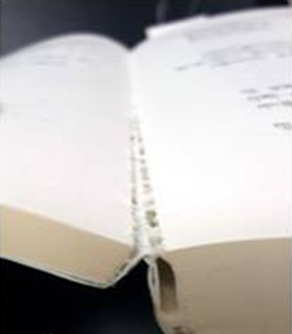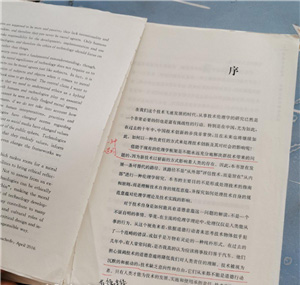Spine Gap
The spine gap significantly affects the aesthetics of the book and can lead to pages coming loose or scattering. The cause of spine gapping may be serious issues with the hot melt adhesive itself, such as impurities causing bubbles during melting. It could also be due to insufficient glue application or uneven glue application, inadequate contact between the glue roller surface and the book core, or poor parallelism of the glue roller causing the gap. Additionally, if the rubber scraper presses too tightly or is too hard, it may scrape off the applied glue, resulting in a spine gap.
 Solutions:
Solutions:
Choose high-quality hot melt adhesive and conduct a trial with a small batch before confirming.
Adjust the machine to ensure good contact between the glue roller surface and the book core.
Adjust the distance between the rubber scraper and the book core to prevent excessive contact or soften the rubber if needed.
Adhesive Opening
Adhesive opening occurs when the bond between the cover and the book core is not strong enough, leading to issues like front or back cover opening or partial opening. This can result from frequent machine stops during operation, causing the cover to not bond within the open time of the glue, or variations in thickness within a batch of booklets, causing poor contact for thinner ones.
Solutions:
Minimize machine stops during normal operation.
Reheat and press books using the hot press method for those with adhesive opening issues.
Bundle and compress folded pages to ensure consistent booklet thickness.
If adhesive opening occurs in a batch, possible reasons include improper adjustment between the two glue rollers, inappropriate adhesive type, incorrect adhesive temperature, or excessive clamping distance during bookbinding.
 Solutions:
Solutions:
Choose the correct adhesive type based on paper type.
Adjust the glue roller spacing to ensure uniform and adequate glue application.
Follow the technical parameters for adhesive temperature.
Adjust the clamping block distance correctly based on the actual booklet thickness.
Page Drop and Scattering
Some perfect binding machines may experience occasional page dropping when flipping through. Reasons include incomplete milling or gluing of the book core, mismatched insert pages, paper debris blocking slots, or improper adhesive type, quality, or temperature.
 Solutions:
Solutions:
Increase milling and slot depth to ensure adhesive penetration.
Adjust the pressure and parallelism of the folding roller for proper page transport.
Increase vibrator amplitude for even distribution.
Regularly clean equipment to ensure smooth milling device operation.
Exposed Adhesive Roots
When flipping between the first and second pages of a perfect-bound book, adhesive roots may be visible in the spine groove, affecting the appearance and functionality. Causes include hard cover paper and soft book core paper, unequal strengths leading to page tearing, insufficient folding indentation pressure, inappropriate adhesive type or poor adhesive quality, and aging or improper adjustment of the adhesive temperature.
Click to learn more about book printing, sticker printing, medicine box, hardcover book printing, PE bag, Bible printing, paper bag printing, catalog printing, and printing in China.
Solutions:
Choose the appropriate adhesive type and adhere to technical parameters.
Regularly clean the glue pot, ensuring proper glue quantity and avoiding prolonged melting.
Use the adhesive type corresponding to the best paper quality when different types are used.
For thick and hard cover paper, deepen the cover indentation as much as possible without causing indentation marks or paper cracking.
Off-Centered Binding
The binding edge refers to the binding edge of the finished product, and the binding edge width refers to the distance from the graphic area to the finished binding edge. Some people think that perfect-bound books do not have a binding edge, and as a result, the spine is not centered on the layout. In actual work, especially in books with title fonts on the title page, this problem is particularly noticeable.
This is mainly because perfect-bound books cannot open the pages to the spine like stitched books, and during binding, a certain width must be occupied. The binding edge width should be slightly wider than the cut width. The depth of the groove for perfect-bound adhesive binding books is generally 1.0 to 1.2 mm. Some printing companies have found that a binding edge width of about 3 mm results in a perfectly centered spine, which is consistent with the dimensional standards for milling and grooving.
These solutions and considerations can help printing companies address common issues in the perfect binding process, ensuring the production of high-quality bound books.“

Comments
No comments yet. Be the first to react!